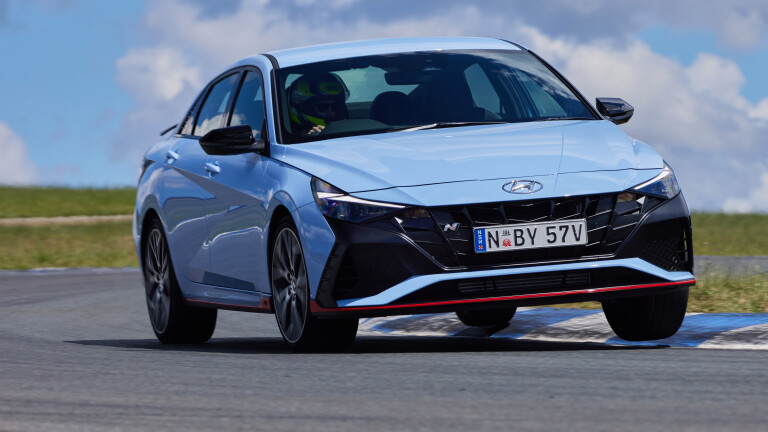
Things we like
- Urban comfort
- Involving and capable dynamics
- Brilliant e-diff
- Genuine track talent
Not so much
- Weightless manual shift action
- Parking sensor false alarm
- Missing some standard kit
Australia was once a nation in love with the sports sedan: affordably priced vehicles with sensible five-seat packaging, and the ability to punch well above their tax bracket.
Over the years, however, the beloved sports sedan has suffered something of a fall from grace. SUVs rose to fashion and, since the demise of our local car industry, new development of notable examples has been few and far between.
Now, Hyundai’s N Division has released the 2022 i30 Sedan N. A slick feature-filled performance sedan keenly positioned at $49k (before on-road costs), representing one of the most compelling cases for a circa-$50k sports sedan in recent times.
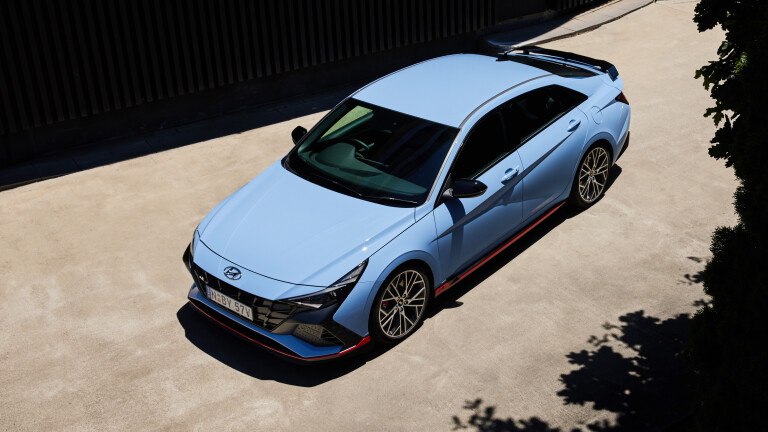
There is only one-spec on offer, so you get the proverbial lot. The only additional costs you can opt for are the sunroof ($2000) and premium paint ($495).
The i30 Sedan N (known overseas as the Elantra), rounds out Phase II of N Division’s rapid rise to stardom within the pantheon of performance cars. The range now consists of the i20 N, i30 N Hatch and Kona N SUV, with the latest offering adding a booted sedan body to the fast family mix.
With eyes on the future, N Division have hinted that the next car in the pipeline will likely be electric, so expect to get familiar with the current range of boosted Korean compacts. Without giving too much away, the Sedan might be the pick of the litter.
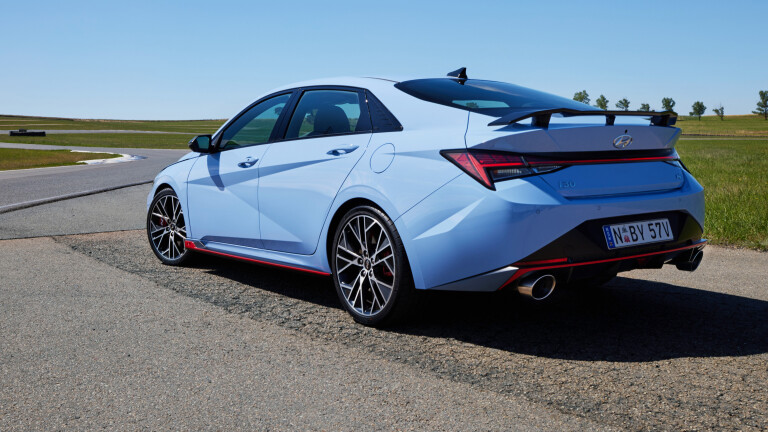
It’s generously equipped for its price point, featuring automatic LED front lights and LED rear lights, active variable exhaust, e-LSD, eight-speaker Bose premium sound system, 10.25-inch digital cluster, 10.25-inch central infotainment screen, Apple CarPlay/Android Auto, keyless start, wireless charging pad, heated and ventilated N Sport front seats, leather upholstery, ambient lighting, dual-zone climate control and 19-inch cast alloy wheels.
There’s also an extensive safety suite as standard, including: blind-spot monitoring, forward collision-avoidance assist, driver attention warning, lane-keep assist, lane-following assist, rear cross-traffic collision avoidance-assist, tyre pressure monitoring, front and rear parking sensors and rear-view camera.
According to Hyundai, it’s also the fastest of the family, and based atop a newer, lighter and more rigid K3 platform. N Division’s prolific drivetrain returns, embracing the 206kW/392Nm 2.0-litre turbocharged T-GDI engine, driving the front wheels via a wet-style eight-speed dual-clutch transmission, or a no-cost option six-speed manual for the three-pedal enthusiasts.
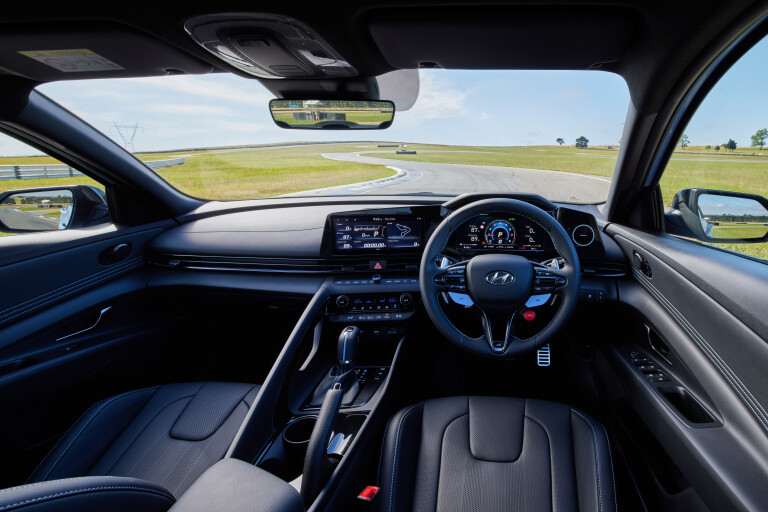
While the main oily bits remain the same, the i30 Sedan N is a vastly different beast under the skin.
The most radical development occurs underneath the front end, with the Sedan N debuting a WRC-derived integrated drive axle (IDA), which reduces complexity and parts count, unsprung mass (1.7kg per corner) and increases rigidity by 55 per cent over the prior flagship i30 Sedan N-Line.
Under the bonnet, the sedan’s larger engine bay allowed engineers to further optimise the intake system, further honing the plumbing with shorter and straighter airflow paths.
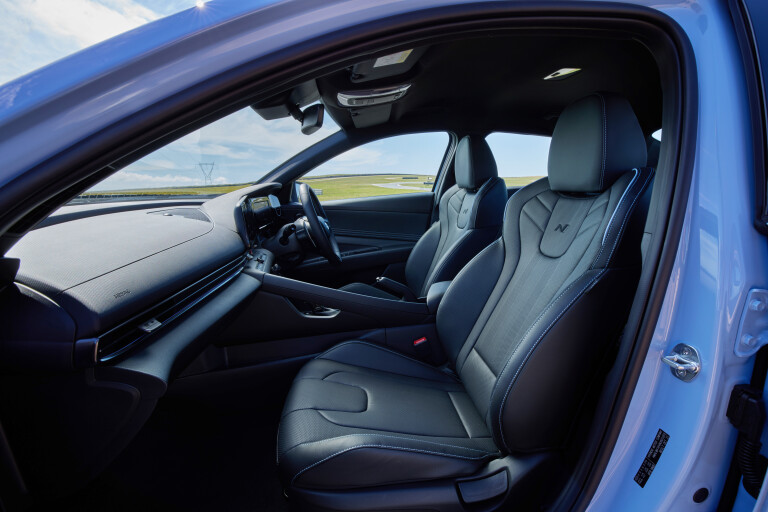
Fire up the starter button, set off down the road and the sedan quickly distinguishes itself from its stablemates. The first revelation is how comfy and plush the ride is.
Normal and Sport suspension settings within the Electronically Controlled Suspension (ECS) have received a unique localised tune. In Normal mode, the Sedan feels plusher than even a Kona N. It’s impressively damped, even more so when you consider that spring rates have increased by 23 per cent at the front, and 49 per cent at the rear, over the existing N-Line. On the highway, it wafts over bumps with a calm rise and fall, with excellent body control under bump and compression.
Varying modes for exhaust, powertrain, suspension and steering offer huge levels of configurability across various aspects of the vehicle. The ability to pre-save two custom settings, toggled intuitively and easily by the two wheel-mounted N buttons, enables you to transform the car’s character to whatever suits the road ahead.
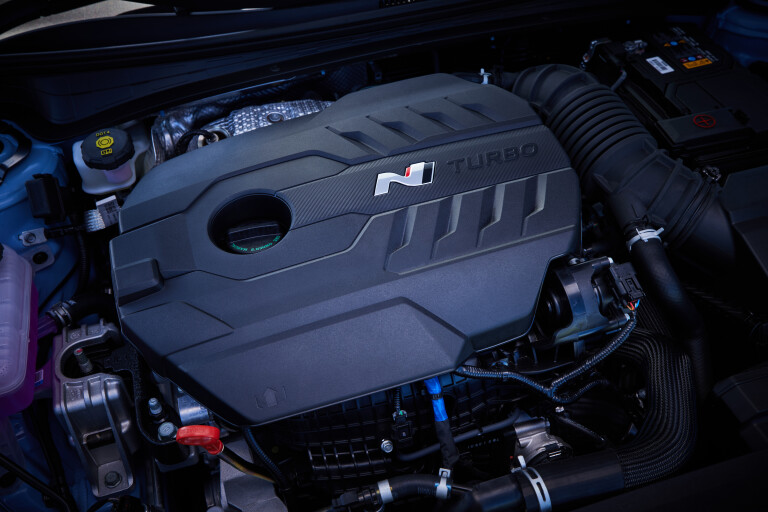
The Sport Suspension setting is perfectly palatable on pockmarked country roads when driving dynamically. N Mode is a performance catchall setting and bears identical tuning aspects to overseas examples. It’s probably best suited to circuits but can be engaged on some smoother roads although there is noticeable jostling and minor head toss over juts and harsh bumps.
The longer wheelbase (2720mm v 2650mm compared to the hatch) yields great high-speed stability, and the local arm has specifically pushed for factory-fitted Michelin Pilot Sport 4S tyres while finalising local packaging. It’s a fruitful decision, as the square-set 245-section tyres boast a greater contact patch than the 235-section Pirelli P Zeros found elsewhere in the showroom. The Michelins, a bespoke blend made specifically for N Division, offer a wider operating window than the Pirellis, too, which are more sensitive to both cold temperatures and heat. They’re also noticeably quieter than the Pirellis.

As our launch route transitions from highway to country road, the pace increases and the car responds in earnest.
The lighter and more rigid front end results in quicker steering and a more immediate response on corner entry. There’s less of a deadzone on-centre and the weight of the steering feels marginally lighter, compared to the i30 N hatch and Kona, but no less precise.
The front tyres do get worked hard, although the front end is always composed and very confidence inspiring. You can feel the electronically controlled limited-slip differential working mid-corner on throttle. It’s a very adjustable car, and very receptive to mid-corner inputs. The front axle will experience push understeer at the limit, but it’s very progressive and you can tighten your line often via steering or by simply scrubbing speed by easing off the throttle. You can provoke oversteer upon liftoff and, even in ESC sport, you can achieve decent levels of yaw without the safety net steeping in.
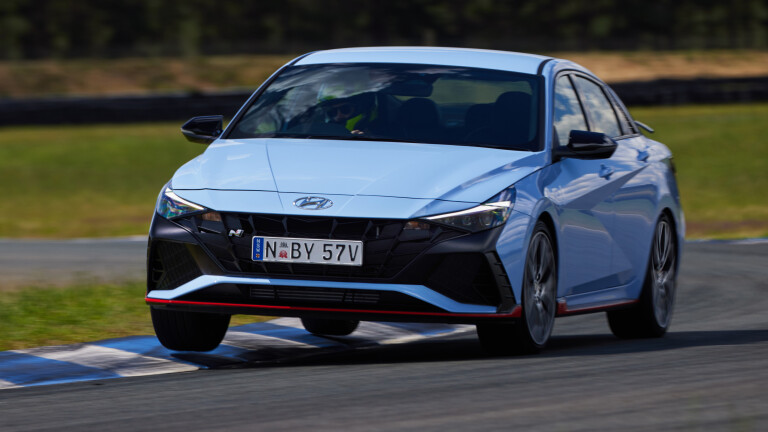
The e-diff continues to work its magic on corner exit, with no detectable axle tramp and minimal torque steer. You can power down much earlier than you expect, with confidence in the car to pull you round.
As the fast and wide flowing roads shrink to smaller tree-lined lanes, it feels smaller than its 4675mm length suggests. In its lightest guise, manual without sunroof, the i30 Sedan N is actually 2kg lighter than the equivalent i30 N Hatch (1445kg v 1447kg). Basic DCT-equipped hatches and sedans are lineball on kerb weight, at 1480kg, despite the sedan measuring a significant 22cm longer in overall length.
In many ways, it feels like a longer Civic Type R, although the power delivery is more instant and linear in its delivery. The Sedan N shares Hyundai’s ‘flat-power’ tuning philosophy, delivering max torque from just 2100rpm through to 4700rpm. Power takes over at the top end, carrying the baton from 5500rpm through to 6000rpm. A standard-fit variable exhaust delivers the N family’s signature array of crackles and pops, and sounds even louder and more aggressive than its brethren, signalling liftoff under hard load with a battery of hellish whipcracks.

In practice, there’s virtually unending thrust and instant response from around 3000rpm, with no detectable drop off before the digital cluster flares red to signal your shift point.
Matched with the eight-speed DCT, it’s an incredibly capable and efficient car to cover ground in. At speed, shifts are a solid and frenetic yet it remains smooth and largely seamless around town. Left to its own devices, the gearbox’s logic is intuitive and decisive, only occasionally settling in a gear to high if you don’t input enough throttle on corner exit. You can easily overcome this by taking the large aluminium paddles into your own hands.
Opting for the eight-speed includes further driver functions, including what’s effectively a push-to-pass overboost. Hit the big red button marked ‘NGS’ (N Grin Shift) on the steering wheel, and a 20-second countdown appears on the digital cluster, temporarily drawing an extra 7kW from the single-turbo four-pot. At more than 90 per cent throttle application, the twin-pack gearbox minimises torque-drop between shifts with a function called N Power Shift (NPS).
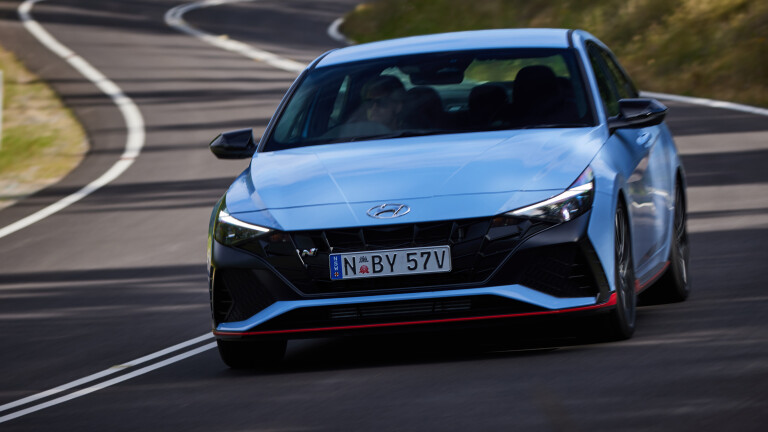
Sadly, these functions aren’t compatible with the six-speed option, the big red button instead toggling Hyundai’s effective rev-matching function. Purists will be glad to know that the three top-mounted pedals are easily heel-toe compatible. Shift action is buttery smooth and accurate, with a light and springy clutch. The throw is long and somewhat weightless, lacking the tactile satisfaction of other units. For those, like me, who like to sit close, it can feel like you’re ‘reaching back’ somewhat when grabbing second, fourth and sixth. It’s a good and effective gearbox, but not a fantastic one.
The launch program of the i30 Sedan N welcomely included a day with Sydney Motorsport Park’s GP circuit at our disposal. Despite hot ambient temperatures, the cars deftly handled almost everything we threw at it. It’s a tremendously composed car, nudging 200km/h down Brabham straight and relishing a 170km/h entry speed through Turn One with both front and rear ends holding fast under steady state throttle. Turn Two, often a double apex, illustrates the effectiveness of the e-LSD, turning in for a single late apex and hugging the inside line with confidence.
Too scared to turn ESC all the way off? Intervention, even in Sport mode, never reared its head. The chassis is inherently well-balanced, shrugging off rapid direction changes, interspersed with a moment of hard braking, through Turns Nine and 10. It’s an involving thing to drive at the track and, with a few courteous cooldown laps sprinkled in between increasingly hot sessions, the large 360mm front, 314mm rear brakes didn’t fade and performed consistently throughout the day.
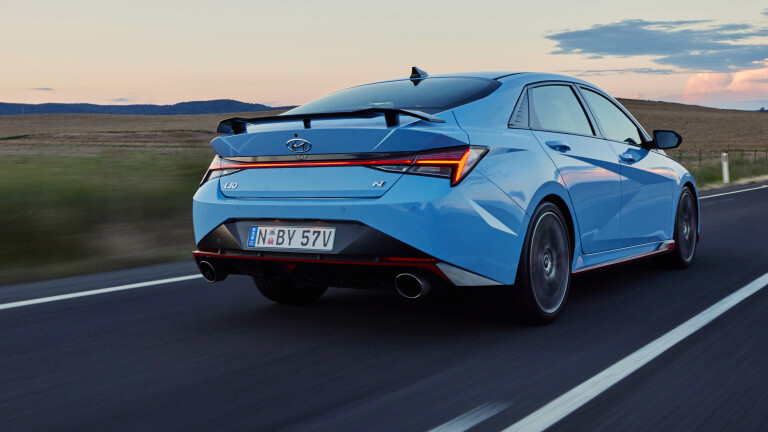
Considering its track day talents, the i30 Sedan N is a captivating multi-faceted package for its price point. There’s depth and maturity to its character, with the ability to effortlessly cruise around in comfort and transform into a capable corner carver with the touch of a button.
We even think it looks cool, if anything, it’s certainly striking. The dominating black elements of the front fascia are polarising, but rest assured it looks better in the flesh (for what it’s worth, we think Cyber Grey wears it best). The car looks purposeful, with huge exhausts, sensible wing-type spoiler, red highlights and chunky diffuser with N Division’s signature triangle rear fog light.
There are some quirks to note, however. Adaptive cruise control is, at a factory level, not available on the i30 Sedan which may irk some buyers. We couldn’t locate a digital speedometer option within the normal instrument display, without engaging N Mode; and the front parking sensors, particularly the front left corner, are prone to going off for no apparent reason when completely stationary (this was observed in multiple cars).
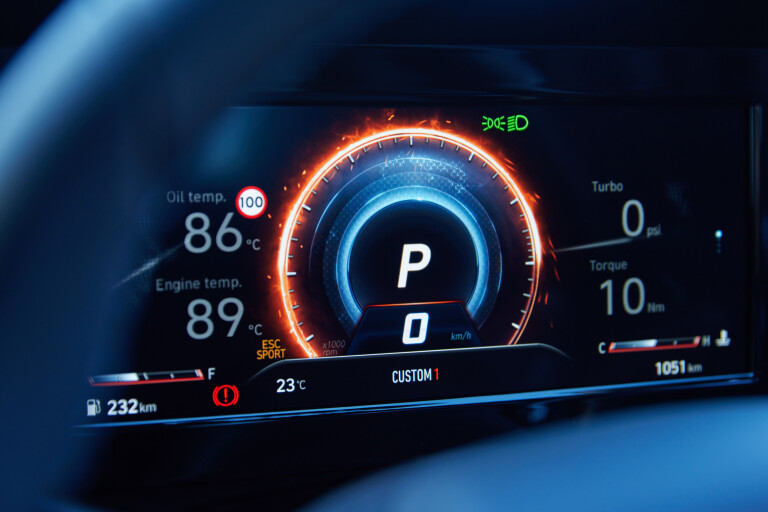
The interior feels solid, sharing most of its hard points and materials with the existing i30 Sedan N-Line. There is hard plastic to be found high on the dash and doors, but the N gains unique door inserts, steering wheel, shifter and seats to lift the ambience. The 10-way power adjusted driver seat can be set nice and low, although the passenger seat is manual with no height adjustment. The long wheelbase affords ample rear space for adults and the boot, at 464-litres, simply dwarfs the Kona N and i30 N hatch’s 361-litres and 395-litres, respectively.
So, the i30 Sedan N is the comfiest of the family, arguably the most practical and every bit as fast. Yet, its sales figures will likely be eclipsed by the more popular hatchback and Kona SUV bodies. That’s a shame, as it occupies a tremendously sweet spot in the range considering the price, equipment and performance included.
It’s hard not to admire N Division, established just four short years ago and, in that time, rapidly ascending to offer a range of segment leading products while upending established players. From here, the future roadmap enters a new chapter with eyes on the horizon as the focus further shifts towards electrification. If this is all we have for now, enjoy the spoils. N Division has saved one of its best for last.
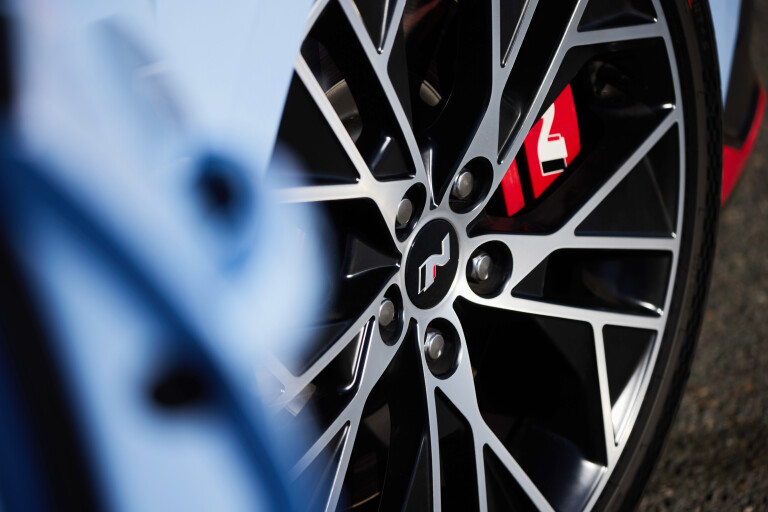
2022 Hyundai i30 Sedan N specs
| Body: | 4-door, 5-seat Sedan |
|---|---|
| Drive: | front-wheel drive |
| Engine: | 1998cc inline-4, DOHC, 16V, turbo |
| Bore x Stroke: | 86 x 86mm |
| Compression: | 9.5:1 |
| Power: | 206kW @ 5500-6000rpm |
| Torque: | 392Nm @ 2100-4700rpm |
| Power/Weight: | 139kW/tonne |
| Transmission: | 8-speed dual-clutch/6-speed manual |
| Weight: | 1480kg |
| Suspension: | MacPherson struts, coil springs, adaptive dampers (f), multi-links, coil springs, adaptive dampers (r) |
| L/W/H: | 4675/1825/1415mm |
| Wheelbase: | 2720mm |
| Tracks: | 1584mm front, 1579mm rear |
| Steering: | electrically assisted rack-and-pinion |
| Brakes: | Dual-Diagonal, Split-Circuit, Power Assisted + EBD. Ventilated discs – 360mm front, 314mm rear |
| Wheels: | 19.0 x 8.0-inch (front/rear) |
| Tyres: | 245/35 ZR19 (front/rear), Michelin Pilot Sport 4S |
| Price: | $49,000 |
Things we like
- Urban comfort
- Involving and capable dynamics
- Brilliant e-diff
- Genuine track talent
Not so much
- Weightless manual shift action
- Parking sensor false alarm
- Missing some standard kit



COMMENTS